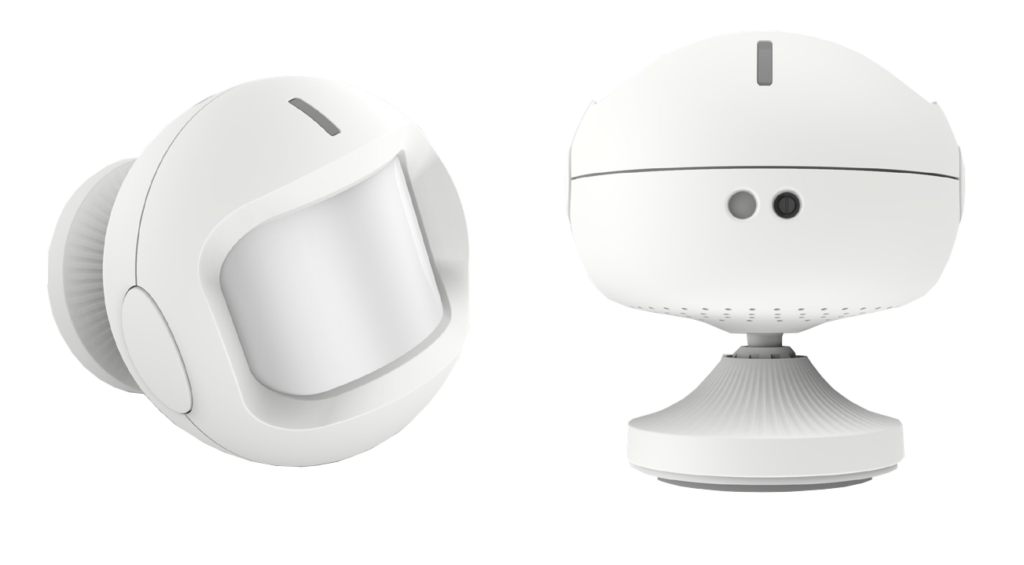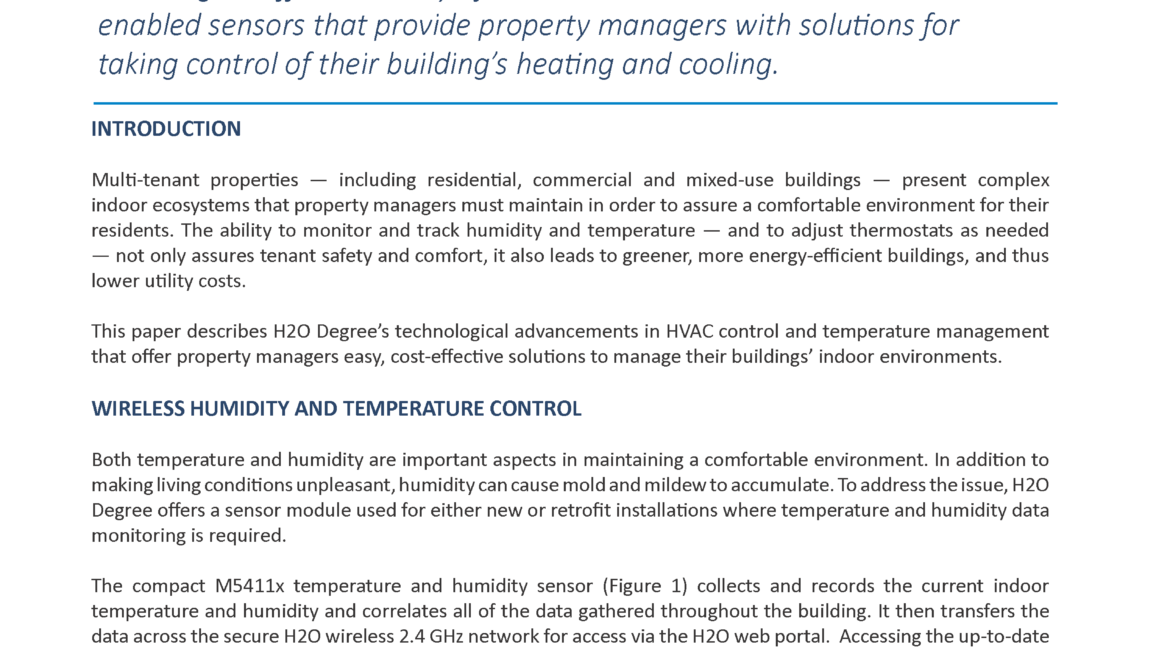INTRODUCTION
Multi-tenant properties — including residential, commercial and mixed-use buildings — present complex indoor ecosystems that property managers must maintain in order to assure a comfortable environment for their residents. The ability to monitor and track humidity and temperature — and to adjust thermostats as needed — not only ensures tenant safety and comfort, it also leads to greener, more energy-efficient buildings, and thus lower utility costs.
This paper describes H2O Degree’s technological advancements in HVAC control and temperature management that offer property managers easy, cost-effective solutions to manage their buildings’ indoor environments.
Wireless Humidity and Temperature Control
Both temperature and humidity are important aspects in maintaining a comfortable environment. In addition to making living conditions unpleasant, humidity can cause mold and mildew to accumulate. To address the issue, H2O Degree offers a sensor module used for either new or retrofit installations where temperature and humidity data monitoring is required.
The compact M5411x temperature and humidity sensor (Figure 1) collects and records the current indoor temperature and humidity and correlates all of the data gathered throughout the building. It then transfers the data across the secure H2O wireless 2.4 GHz network for access via the H2O web portal. Accessing the up-to-date information by their phone or computer, the property manager is better able to control their building’s HVAC system. They can also provide their tenants with the same temperature and humidity information so that they can make decisions based on their individual comfort levels.
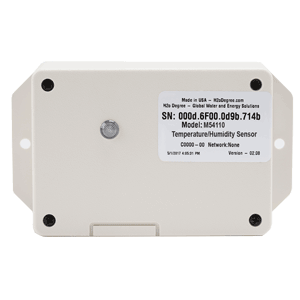
Wireless Thermostat Control
Property managers need to control their building’s heating and air conditioning systems to reign in utility costs. H2O Degree’s wireless green thermostat has the ability to track energy use and indoor temperature. It also allows them — and their tenants — to set temperature set-points and schedules and report HVAC maintenance issues. It also enables setback temperatures to be programmed for when tenants are away or asleep, which results in more precise utility management by monitoring occupied versus vacant spaces.
The H2O Degree thermostat control system comprises the T-1000 battery-operated wireless Green Thermostats (Figure 2) and the H2O Degree dedicated web portal. Simple to install and a direct replacement for many 24 VAC-based units, the networked thermostat maintains local HVAC control, even if network communication is lost. As a “smart” thermostat, it wirelessly communicates with the H2O Degree Gateway and connects to the H2O Degree server in the cloud. Once the data is collected, a daily thermostat anomaly report highlights issues that need to be addressed, including: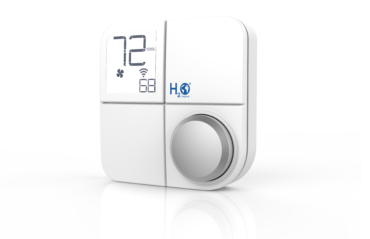
- In-room temperature below or exceeding set-point (indication of possible external heating, e.g. a space heater or air-conditioning source)
- System in need of cooling or heating all day yet never obtaining the temperature set-point (indication of a maintenance equipment failure)
- Correlation of outdoor temperature to actual indoor unit temperature for analysis and adjustment
Tenants can program their thermostat via the web portal or mobile app within the set-points determined by property management (Figure 3). This creates a partnership among management and residents that leads to energy conservation.
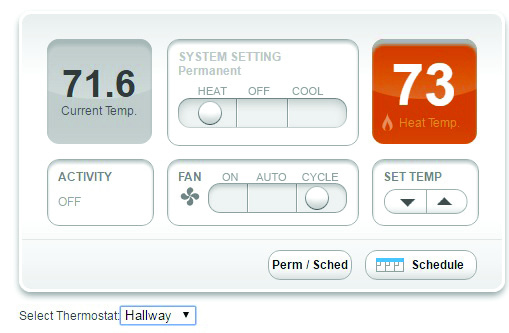
Wireless Network Control
Another solution for helping manage heating and cooling energy costs is the H2O Degree Mini Relay Module (Figure 4). The W54455-MIN is a wireless relay module that provides a compact and economical solution for controlling such devices as baseboard heaters, zone valves and lighting. It can also be paired with the H2O Degree green thermostat to control heating.
The H2O Degree Mini Relay Module is a fully functional, line-powered wireless network node with an integrated relay and current detector. Used for multiple applications, it is available in a choice of 120 VAC or 208-240 VAC configurations. The module connects directly to a baseboard heater or other electrical device that needs to be controlled and monitors loads up to 15 amperes of current. For easy mounting, it includes an integrated industry-standard 1/2″ box connector, as well as three, small LED lights that indicate power, link and relay status.
Wireless Hydronic Heating Control
For wireless control of energy-harvesting radiator actuators, H2O Degree offers the HCH0104 Hydronic Radiator Control System. Many older multi-family properties use this type of central plant hydronic heating system, which generates hot water to radiators throughout the property to deliver heat to each apartment. The system’s wireless design makes it ideal for retrofit installation and cost-sensitive projects where the cabling cost is prohibitive.
Figure 5 illustrates the integrated system. The wireless radiator actuator mounts directly onto the thermostatic radiator valve bodies where it controls the room temperature, based on signals from the HCH0104 Smart Thermostat and Zigbee to EnOcean Bridge.
The HCV0104 Wireless Radiator Actuator contains a thermoelectric harvesting module, internal energy storage, an electromechanical valve actuator, a radio module and a microcontroller. The HCH0104 Smart Thermostat and Bridge communicates wirelessly with the H2O Degree cloud server. Utilizing this system, property managers can view all the thermostat values such as set-points and temperature readings on H2O Degree dashboards and adjust units individually or adjust all units site-wide. They can also give residents access to their in-unit thermostat through a web-based portal or mobile application that allows remote control of their temperature set-points that wirelessly actuate the radiator valves.
LoRaWAN Enabled Sensors for Added Control
H2O Degree also offers internet-enabled temperature/humidity, door/window-open and occupancy sensors that communicate over the LoRaWAN open-protocol network. Targeting multi-tenant buildings that are under construction, renovation, for rent — or otherwise unoccupied — these compact sensors alert off-site property managers or maintenance staff so that they can take immediate action. By installing multiple, low-cost sensors to their wireless thermostat control installations, property managers can obtain even more control of their utility expenses.
In addition to temperature/humidity sensors, property managers can also install sensors on the doors and windows throughout unoccupied spaces. Tracking door and window movement using a magnetic open/closure sensor, the LS1000 LoRaWAN Door/Window Sensor is also ideal for the application described above. Like the humidity sensor, the door/window sensor integrates with the LoRaWAN wireless network to provide low-cost, compact monitoring.
Property managers can also employ H2O Degree’s LS3000 LoRaWAN occupancy sensors (Figure 6) to monitor the environment and receive real-time information about the motion, lighting and temperature activity in a designated area. Smart and configurable, the device can be set to report information. In the application example described here, the property manager can use it to “see” if someone is present to shut the window or investigate further.
Conclusion
H2O Degree’s thermostat monitoring and control devices utilize the company’s unique two-way wireless network so that property managers can access monitoring data over their phones and computers. These products — a wireless humidity sensor, smart thermostat, relay module, and a hydronic radiator control system — help managers get a handle on their buildings’ indoor environment. For even more control when located off-site, they can install multiple, internet-enabled LoRaWAN sensors to help detect humidity, temperature, open windows/doors and motion.
In addition to optimizing the air temperature for their tenants, the H2O Degree’s thermostat control system can generate utility usage data for property management. Property managers and owners are able to bill tenants for their actual energy usage for heating and cooling through the run-time feature in the thermostat. As a result, they create an incentive for behavioral change among tenants to conserve energy. According to H2O Degree’s internal research, such savings from reduced utility costs have exceeded 20% in multiple properties.
For more information visit www.H2ODegree.com, call (215) 788-8485 or email info@h2odegree.com.
For a free site evaluation complete our online form at www.H2ODegree.com/sitesurvey





